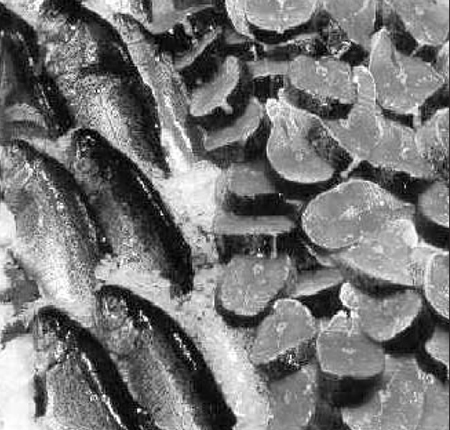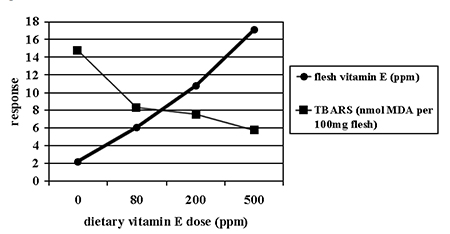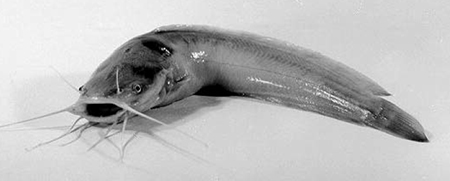Vitamin E is considered safe, even in high doses

Vitamin E, or alpha-tocopherol, is important to fish tissue’s defense against lipid-oxidising free radicals. It is by far the vitamin with the greatest impact on flesh quality. Increased vitamin E supply to living tissues generates stability against peroxidation of flesh following harvest, which improves the quality and storage stability of meat and fish products.
Vitamin E supplementation prolongs the time that meat products such as beef, veal, pork, poultry and fish may be kept. Because of the high degree of polyunsaturation of their lipids, fish tissues are susceptible to oxidation. Studies on salmonids, channel catfish, red sea bream and my work on African catfish have demonstrated the protective effects of vitamin E against lipid peroxidation in stored tissues.
Higher tissue vitamin E, greater stability

In African catfish, the concentration of vitamin E in muscle is related to dietary inclusion. Even at a dietary inclusion level twice as high as the normal salmonid dose (200 to 300 ppm), scope exists for further deposition of alpha-tocopherol in the flesh. Increasing vitamin E content in fish muscle suppresses lipid-oxidation in fillets (Fig. 1). Vitamin E in the flesh suppresses formation of thiobarbituric acid reactive substances, or TBARS, because it is able to prevent the breakdown of lipids to malondialdehyde (MDA), the compound that reacts with thiobarbituric acid in the chemical test. TBARS measurements parallel resistance to oxidation of meat products under retail conditions, so fillets from catfish fed elevated levels of vitamin E have a longer shelf-life.
Health and flavor benefits
A further benefit is vitamin E’s protection of polyunsaturated fatty acids within foods, so that dietary antioxidant supplementation and fatty acid protection ensures carry-over of both of these important nutrients into humans. Improved stability and protection of polyunsaturated fats and cholesterol by vitamin E is linked to reduced risk of coronary heart disease in humans. With fish tissues being a rich source of important unsaturated fats, higher vitamin E levels in cultured fish passes on health benefits to the consumer.
Taste-panel evaluations demonstrate an improvement of flesh taste by increasing the vitamin E given to trout. Although alpha-tocopherol imparts no flavor to food, it exerts its influence by controlling peroxidation in muscle lipids. The process of oxidative rancidity creates lipid peroxidation products including alcohols, aldehydes and ketones, all of which result in off-tastes. Vitamin E acts as a chain-breaking antioxidant, terminating the oxidation reactions that go unchecked in vitamin E’s absence.
Vitamin E reduces drip loss from meat
Given that oxidation of membranebound fatty acids leads to increased rigidity of the membrane, vitamin E influences the fluidity of cell membranes. Therefore, it reduces the potential for cytosolic leakage from the cell, and this protects the cell membrane from mechanical freeze-damage. Increased drip loss in thawed animal tissues low in vitamin E has been reported for fish (Baker, 1997), as well as other species.
Vitamin E is unlikely to have a role governing eating quality in terms of texture and softness. Softness is probably influenced by muscle fibre arrangement, lipid distribution and water content of the flesh. However, in extreme vitamin E deficiency, nutritional muscular dystrophy results and this affects muscle structure. Also, oxidation of flesh protein and associated crosslinking may result from acute vitamin E deficiency.
Environmental impacts

Fish lipids can be damaged by free radical species generated by ionising radiation, or from many metabolic reactions occurring within the body. Also, many of the body’s cellular defense mechanisms rely on controlled production of bactericidal free-radicals by phagocytes. Leakage of free-radicals from specific pathways, leads to initiation of lipid peroxidation, possibly with implications in terms of flesh quality.
External oxidation-stressors include UV radiation, exercise rate changes and temperature, and these may play a role in fish health. Higher rearing temperature increases respiration rate, increases through-put of oxygen, and this may accelerate formation of radicals. There is little information on the influence of these factors, but mechanisms responsible for the degradation of vitamin E in fish tissues must be considered as potentially detrimental to the overall oxidative status.
Protecting the protector
We have discussed that vitamin E is a potent protector of biological tissues, but obviously this also means that it is itself prone to oxidation. This poses problems to the feed manufacturer since the free form of vitamin E, alpha-tocopherol, can be easily oxidised during the feed manufacture process or during storage. For these reasons, the preferred supplement source is alpha-tocopheryl acetate as this does not function as an antioxidant until it is ingested and then hydrolysed back to the free tocopherol in the gut. In addition, the tocopherol forms exist as viscous oils, so that specialised formulation technology is applied to convert vitamin E into a free-flowing, dry powder.
Adding value through feed
Research into vitamin E’s role in flesh quality improvement is ongoing. Due to its antiradical role, any combination of feed or environmental oxidantstress could decrease tissue vitamin E stores so that health and product quality suffer. Vitamin E is considered as very safe, even in high doses, so that there is the possibility to increase its supplementation into fish diets. Because of the multitude of benefits to the quality of fish flesh, dietary vitamin E addition is seen as a practical and cost effective means of adding value to aquaculture products.
(Editor’s Note: This article was originally published in the April 2000 print edition of the Global Aquaculture Advocate.)
Now that you've finished reading the article ...
… we hope you’ll consider supporting our mission to document the evolution of the global aquaculture industry and share our vast network of contributors’ expansive knowledge every week.
By becoming a Global Seafood Alliance member, you’re ensuring that all of the pre-competitive work we do through member benefits, resources and events can continue. Individual membership costs just $50 a year. GSA individual and corporate members receive complimentary access to a series of GOAL virtual events beginning in April. Join now.
Not a GSA member? Join us.
Author
-
Dr. Rémi Baker, Ph.D.
Global Technical Marketing
Manager - Carotenoids
BASF AG. MEM/BC-D205
67056 Ludwigshafen, Germany[101,100,46,103,97,45,102,115,97,98,64,114,101,107,97,98,46,105,109,101,114]
Tagged With
Related Posts

Intelligence
Adding value to tilapia to tap into U.S. market
New markets for tilapia and expansion of existing ones can be created by planning and implementing properly designed geographic strategies to meet discriminating consumer preferences. Low labor costs in most producing countries promotes value-adding by the production of fresh fillets.

Intelligence
Expanding tilapia supply meets growing global market
Global tilapia production and consumption growth has mirrored the species' versatility. The fish will remain integral to rural aquaculture development.

Intelligence
Quality control measures improve tilapia production chain in Latin America
The experiences of tilapia farmers combined with effective quality control programs implemented by government have improved production in Mexico, Colombia, Ecuador, Peru and other Latin American countries.

Innovation & Investment
Five critical questions we must answer to grow this industry
Some investors like what they see in aquaculture and its potential to produce wholesome, high-quality food for a growing population. But critical questions must be answered if the industry is to attract the amount of money it needs.


